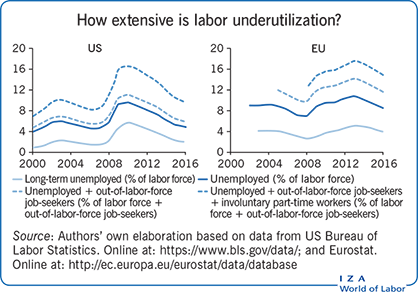Elevator pitch
Measuring employment and unemployment is essential for economic policy. Internationally agreed measures (e.g. headcount employment and unemployment rates based on standard definitions) enhance comparability across time and space, but changes in real labor markets and policy agendas challenge these traditional conventions. Boundaries between different labor market states are blurred, complicating identification. Individual experiences in each state may vary considerably, highlighting the importance of how each employed or unemployed person is weighted in statistical indices.

Key findings
Pros
- The definitions of employment and unemployment are simple and enhance comparability across time and space.
- The unemployment rate is a very useful tool for macro analysis.
- Experience-weighted measures can account for variation in work characteristics (e.g. working time) and job search behavior (e.g. duration of unemployment) across countries and years.
- Alternative indices broaden information for policy making and may account for diverse value judgments.
Cons
- Boundaries between labor market states are blurred.
- The definition of employment ignores differences in work arrangements (e.g. part-time, discontinuous working time) that influence total work potential and well-being.
- The definition of unemployment overlooks differences in search intensity and unemployment duration, despite their relevance for welfare losses and probability of finding a job.
- Alternative indices require the development of appropriate statistical sources and their underlying methodology can be difficult for the general public to understand.
Author's main message
As life-long, permanent, full-time work is increasingly replaced by multiple job spells, often intertwined with periods of non-employment and engagement in non-market activities, it is worth revisiting the notions of employment and unemployment and broadening the set of labor force statistics. Headcount indices could be usefully supplemented by experience-weighted indices that account for people's experience in labor market states (e.g. work intensity for the employed and search intensity or unemployment duration for the unemployed). This task likely implies collecting new statistical data, but would improve policy design and understanding of the labor market.
This article first appeared on IZA World of Labor in August 2018. Reproduced with permission



